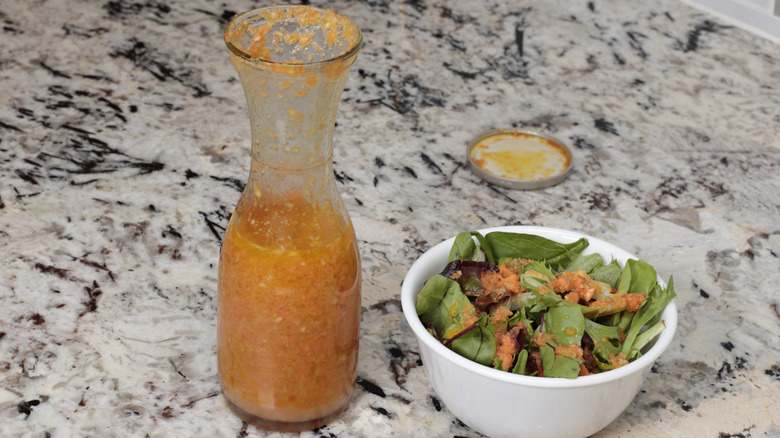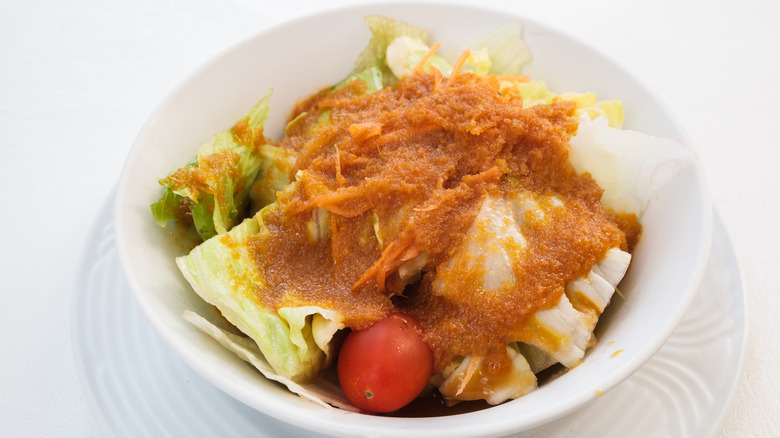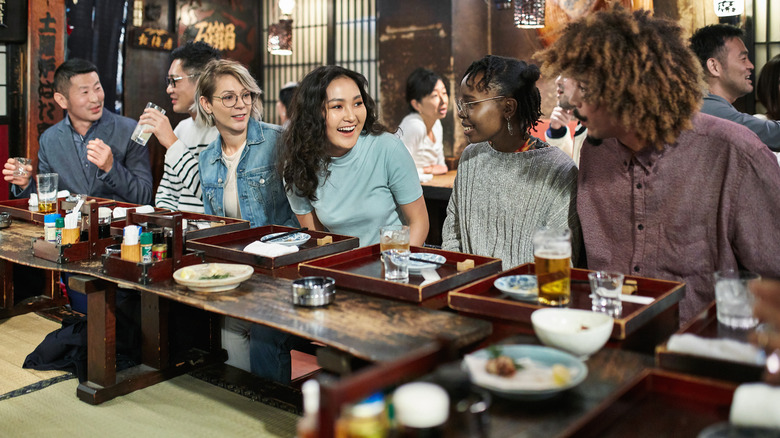Why Ginger Dressing At Sushi Restaurants Is Usually Orange
Fans of Japanese cuisine are no doubt familiar with the ubiquitous ginger dressing found at many Japanese restaurants and sushi establishments in the U.S. This dressing, which usually arrives alongside the salad served during the first course, is easily identifiable by its signature orange hue and delightfully tangy flavor profile. Some have wondered where this fan-favorite dressing gets its vibrant color, and the answer lies in the ingredients typically used to create the many varieties of ginger dressing.
While recipes vary greatly from restaurant to restaurant, many brands of ginger dressing feature carrots, which could explain their orange tint. Along with their appealing color, the flavor of carrots also pairs quite nicely with ginger. The mild sweetness of carrots complements the subtle warmth imparted by ginger, which makes the combination of flavors ideal for livening up salads. However, ginger dressing can also contain many similarly hued ingredients, and this combination of ingredients is likely responsible for the color of the much-loved ginger dressing.
Other possible ways ginger dressing gets its color
In addition to carrots, ginger dressing can also contain lots of other ingredients that influence not only flavor but color as well. And while these ingredients might not be specifically orange, their similarity to the bright shade can impact the appearance of ginger dressing. For instance, ginger dressing varieties may also contain tomato paste, which can render the finished product orange when combined with other elements. As for flavor, tomato paste is also likely to increase the tanginess of the dressing, which is a large part of its appeal. Additionally, some brands opt for ketchup instead of tomato paste, which has a similar effect on both the taste and color of the dressing.
Apple cider vinegar is another common component of ginger dressing that appears slightly orange. The high acidity level of apple cider vinegar also infuses food with a pleasant brightness, which could explain why it's a common ingredient in dressing. These ingredient combos make it easy to see why most ginger dressing is orange. However, why this dressing is so popular at Japanese dining establishments and sushi restaurants in America remains somewhat unseen.
The history of sushi restaurants in the U.S.
As reported by Michelin Guide, sushi has been served in America since the 1960s, so American diners have been enjoying the preparation for some time. However, the opening of Kawafuku in that decade is generally considered to have kicked off the modern wave of sushi restaurants in the U.S. Other establishments followed suit, which caused sushi to grow in popularity over the subsequent decades. These days, there are more than 16,000 sushi restaurants throughout the nation, a figure that has continued to rise steadily over the past few years.
As for why carrot ginger dressing is now a mainstay at Japanese restaurants in America, that's not quite as clear cut. Chef Yohei Matsuki told the Michelin Guide, "American people want vibrant colors and highly decorated sushi," which might explain why the brightly colored orange dressing is such a big hit at sushi restaurants within the U.S. What is certain is that you're likely to find orange-colored ginger dressing at many of the best sushi establishments in America.


